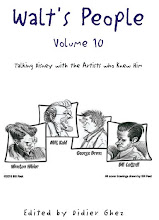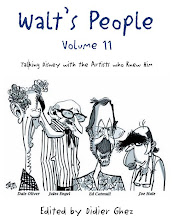 Russell Merritt's and J.B. Kaufman's Walt Disney's Silly Symphonies book is a pure delight. The only slight disapointment are the illustrations. I would have loved to see concept art of more unusual documents related to the Silly Symphonies. There are a few visual documents, though that match the stunning quality of the text and the research. One of those is a photo of the Russian Three Little Pigs poster.
Russell Merritt's and J.B. Kaufman's Walt Disney's Silly Symphonies book is a pure delight. The only slight disapointment are the illustrations. I would have loved to see concept art of more unusual documents related to the Silly Symphonies. There are a few visual documents, though that match the stunning quality of the text and the research. One of those is a photo of the Russian Three Little Pigs poster.The shorts The Three Little Pigs, Peculiar Penguins and The Band Concert were shown in the mid-'30s at Moscow's Art Film Theatre. The Three Little Pigs even received a special award at the Moscow Film Festival in 1935.
While Russell and JB show the poster, I believe what I am displaying here is the full program was given to people attending the Moscow Film Festival. Or is it? Can one of the visitors of this site speak Russian and give me more information about this extremely rare document that has been part of my collection for years?




























4 comments:
Wow! What a treasure! Thank you for this document…
I'm from Russia and certainly can read this. Though, it is much more difficult to translate it. It is curious to me to see some old-fashioned terms. Anyway I’ll try to retell these texts.
On the second page Saveliy Ruben write that the cartoons THREE LITTLE PIGS, PECULIAR PENGUINS and THE BAND CONCERT are produced by United Pictures and Walt Disney acted in a role of artist and director of its. He received the award of the third degree at the First Soviet film festival. There is a remark that these cartoons were made with help of three-colored photography (Technicolor).
On the third page the main text begins.
It is said that Mickey Mouse and Silly Symphonies cartoons are very popular at the West and shown in 88 countries. American artist Walt Disney excellently integrate all kinds of arts including painting, music and dance. The drawing, movement and music are main components of Disney’s films and they subordinate not only characters but the inanimate objects which all take a part in the whole rhythm. The stories are not so good. They are frivolous and their main task is to distract from evident reality, from essential cares and social problems of the bourgeois world. Still Disney’s cartoons are fascinating show thanks to brilliant technique of drawing’s movement and mathematical accuracy of concurrence of a sound and line.
Further the production process is described very briefly and not so clearly (at least in my opinion). There are also some facts. For example it is said that production of THE THREE PIGS took 15 months and cost more than 2 million of francs (I don’t know why they used the French currency though I read that one hundred years ago the French language was a main competitor to English in the world so maybe these facts are connected). Disney’s studio produces up to the 20 cartoons every year and spends 15 millions francs. The Disney cartoons make huge profits despite of greater expenses and the overexpenditure of film (since Technicolor uses a film three times more than usual photography).
There is short biography of Walt Disney on the page #6. There is a mention that Disney had a trouble with getting a financing of his first color cartoon. Later the speech comes about color in live action movie CUCARACHA directed by Lloyd Corrighan. Then author write about Russian experiments with color. It is said that they very successfully used two-colored photography in cartoon named CARNAVAL OF FLOWERS.
On last pages the plots of Disney cartoons are described.
The brochure was printed in November 1935.
I want to add from myself that the story of three pigs was very popular in Soviet Union and the famous song was translated and adapted in Russian (moreover later years nobody remember that this was American song). The pigs had names Nif-Nif, Nuf-Nuf and Naf-Naf.
Alexey Kobelev
Well, as far as I can see it is a program, printed in Leningrad 1935, of "American Color Films", first Three Little Pigs then Peculiar Penguins, Band Concert and finally the short film La Cucaracha by Lloyd Corrigan, 1934. It also features a piece about Walt Disney, with a story about him coming to Hollywood in 1932, Flowers and Trees in 1932 and using Technicolor...
Alexey,
Hans,
Thanks a million for these translations!
Not only are they using the French currency in their explaination, the names of the pigs are the ones they have in French: Nif-Nif, Naf-Naf and Nouf-Nouf. French influence in Russia was indeed extremely strong at the time.
I'm glad to see the precise translation by a native Russian! I just wanted to add that I am JUST NOW reading a little book about Technicolor in which the 2-reel 1934 RKO La Cucaracha is mentioned as the very first live-action 3-strip Technicolor film, made as a test for $65,000 when most shorts cost $15,000.
The book makes a distinction between Successive Exposure Technicolor as used from Flowers and Trees in 1932 until Robin Hood in 1973 for all animation, and the live action Technicolor process where all three frames are exposed at the same time. Sadly, dye-transfer printing was officially abandoned in 1974 (at the time of the writing of the book (1993), they still did it in Beijing). One of the most amazing dye-transfer prints I have seen was at the 3-d festival last year, where they screened the only test reel of Disney's Melody in 3-d, with each eye printed on each side of the film stock, and it was PRINTED Polarized. An amazing experiment that was abandoned when CinemaScope took over in the novelty projection business...
(Technicolor Movies: The History of Dye Transfer Printing by Richard W. Haines)
Post a Comment